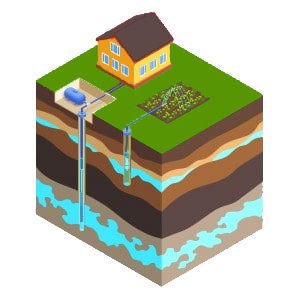Summers seem to be getting hotter and drier. Then soon you will have to water at least once a week to keep your garden alive. Therefore, many people choose to build a well in the front or backyard. You can also drill wells to use as drinking water. Or build a cistern to save costs. The choice of what all you want to use the well for affects the type of well and borehole.
But constructing a water well involves drilling or digging into the subsurface. There are several factors to consider when drilling a water well. In this article, we name the most important aspects for digging or drilling a water well.
Important to know is that you are not allowed to (machine) drill in the garden just like that. You are required to file a Klic notification to find out where cables and pipes may lie. This helps prevent digging damage.
>> Request Klic report <<
Another thing not to forget:

In general, the deeper the well is drilled, the cleaner the water will be. A shallow borehole in the Netherlands is often already around 6 meters deep. This can then be used for watering the garden. With a drilled well, good drinking water is extracted at an average of 40 to 60 meters. The larger cisterns have a height of about 2 meters. Because of this, you soon have to go 3 to 4 meters into the ground.
In general, you can drill your own well/water source for irrigation. Each province/municipality may have (extra) rules. In any case, check with your municipality.
Since 2017, however, drilling a well for groundwater extraction must be done by a licensed drilling company.
You do not have to apply for permits in all municipalities or for a water well if it is a so-called small abstraction. Often the rules of thumb are:
Some municipalities do require you to obtain a permit for groundwater withdrawals. This can be the case, for example, for:
In short: whether you need a permit may vary by municipality and situation. Therefore, always check first with your municipality whether you need it yes or no.
A Klic report is not a permit, but it is required when drilling a well. The WIBON law states that in the case of machine digging, you must request a Klic notification prior to the work.
>> Request Klic report <<
Drilling or drilling a well is almost always done mechanically. When a private individual or company uses machine digging (also known as soil stirring), you are required to submit a Klic notification. Also, if you plan to dig without a machine, but you get deeper than 40 centimeters: then you are also obliged to file a Klic notification.
Curious as to why it is obligatory to apply for a Klic notification in your own garden, for example? Read the article about digging in the garden.
>> Request Klic report <<
The cost of digging a well in your garden varies. It depends of course on whether you will use it only for irrigation or also for drinking water.
A rough indication of the costs for a well for irrigation is an investment of one thousand to two thousand euros. With this you can water your garden with water from your own well.
If you opt for a cistern, for example, in terms of costs, you will save mainly on your current water consumption. By investing in a cistern, these costs can be reduced immediately. For example, you can connect your toilet to it, water the garden with it and clean your house or your car with it.
Something a bit more unrelated to cost, but important: be aware that if you have a well, realize that even that source is not inexhaustible.
Once the well is dug, it is important to cover it so that dirt and other contaminants do not get into the water. In addition, it is important to regularly maintain the well, testing and checking that it is safe to drink from.
Digging a well can offer several advantages over using municipal drinking water. First, it can be cost effective. Digging a well may be more expensive at first, but over time you will spend significantly less money on water bills. Second, you have a reliable source of water. Municipal water supplies are sometimes subject to breakdowns, which means you can run out of water. Digging a well ensures that you always have access to water.
Digging a water well can be a challenging process, but it is generally not too difficult if you follow the right steps. The process begins with selecting the right location for the well. This depends on several factors, such as distance from the home, distance from other wells and the geology of the soil. Next, it is important to gather the necessary tools and equipment, such as a drill, a pump and pipe to line the well.
Once the location and depth of the well is determined, excavation work can begin. It is important to make sure you have the proper equipment and necessary permits when digging a water well. For example, when machine digging, it is mandatory to apply for a Klic Notification. This Klic-Melding provides an overview of the cables and pipes under the ground and ensures a safe excavation process.
>> Request Klic report <<